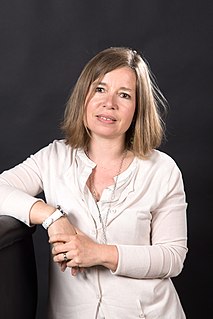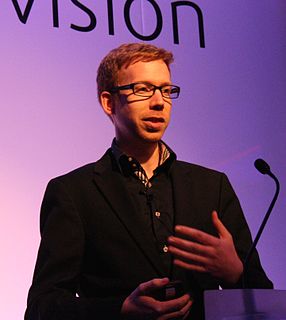Middleware in the context of distributed applications is software that provides services beyond those provided by the operating system to enable the various components of a distributed system to communicate and manage data. Middleware supports and simplifies complex distributed applications. It includes web servers, application servers, messaging and similar tools that support application development and delivery. Middleware is especially integral to modern information technology based on XML, SOAP, Web services, and service-oriented architecture.
The École polytechnique fédérale de Lausanne (EPFL) is a public research university located in Lausanne, Switzerland. It specializes in natural sciences and engineering. It is one of the two Swiss Federal Institutes of Technology, with three main missions: education, research and innovation. The QS World University Rankings ranked EPFL as the 14th best university in the world across all fields in 2021, whereas THE World University Rankings ranked EPFL as the world's 19th best school for engineering and technology in 2020.
A mashup, in web development, is a web page or web application that uses content from more than one source to create a single new service displayed in a single graphical interface. For example, a user could combine the addresses and photographs of their library branches with a Google map to create a map mashup. The term implies easy, fast integration, frequently using open application programming interfaces and data sources to produce enriched results that were not necessarily the original reason for producing the raw source data. The term mashup originally comes from creating something by combining elements from two or more sources.
The Idiap Research Institute is a semi-private non-profit research institute at Martigny in the canton of Valais, in south-western Switzerland. It conducts research in the areas of speech processing, computer vision, information retrieval, biometric authentication, multimodal interaction and machine learning. The institute is affiliated with the École polytechnique fédérale de Lausanne (EPFL), and with the Université de Genève.

A computerized appliance, or simply a computer appliance, is a computer with software or firmware that is specifically designed to provide a specific computing resource. Such devices became known as appliances because of the similarity in role or management to a home appliance, which are generally closed and sealed, and are not serviceable by the user or owner. The hardware and software are delivered as an integrated product and may even be pre-configured before delivery to a customer, to provide a turn-key solution for a particular application. Unlike general purpose computers, appliances are generally not designed to allow the customers to change the software and the underlying operating system, or to flexibly reconfigure the hardware.
The Internet of things (IoT) describes physical objects with sensors, processing ability, software, and other technologies that connect and exchange data with other devices and systems over the Internet or other communications networks. Internet of things has been considered a misnomer because devices do not need to be connected to the public internet, they only need to be connected to a network and be individually addressable.

Martin Vetterli is the current president of École Polytechnique Fédérale de Lausanne (EPFL) in Switzerland, succeeding Patrick Aebischer. He's a professor of engineering and was formerly the president of the National Research Council of the Swiss National Science Foundation.
InetSoft Technology Corporation is a privately owned multinational computer software company that develops free and commercial web-based business intelligence applications. The company was founded in 1996, and currently has over 120 employees between its corporate headquarters in Piscataway, New Jersey, and development offices in Beijing and Xi'an, China.

Matthias Finger is Swiss and French political and educational scientist. He was a professor of management of network industries at EPFL.
Web of Things (WoT) describes a set of standards by the World Wide Web Consortium (W3C) for the interoperability of different Internet of things (IoT) platforms and application domains.
Alain Wegmann is a Swiss computer scientist, professor of Systemic Modeling at the École Polytechnique Fédérale de Lausanne (EPFL), and Information Technology and Services consultant, known for the development of the Systemic Enterprise Architecture Methodology (SEAM).
Anastasia Ailamaki is a Professor of Computer Sciences at the École Polytechnique Fédérale de Lausanne (EPFL) in Switzerland and the Director of the Data-Intensive Applications and Systems (DIAS) lab. She is also the co-founder of RAW Labs SA, a Swiss company developing real-time analytics infrastructures for heterogeneous big data. Formerly, she was an associate professor of computer science at Carnegie Mellon School of Computer Science.

EVRYTHNG is an internet of things software company based in London, San Francisco and New York City. The company manages digital identity data in an intelligent IoT "smart products" cloud to connect "consumer packaged goods" to the Web and drive real-time applications. Niall Murphy, Andy Hobsbawm, Dominique Guinard and Vlad Trifa founded the company in January 2011. Murphy is the company's founding CEO.

Henry James Snaith is a professor in physics in the Clarendon Laboratory at the University of Oxford. Research from his group has led to the creation of a new research field, based on halide perovskites for use as solar absorbers. Many individuals who were PhD students and postdoctoral researchers in Snaith's group have now established research groups, independent research portfolios and commercial enterprises.

Annalisa Buffa is an Italian mathematician, specializing in numerical analysis and partial differential equations (PDE). She is a professor of mathematics at EPFL and hold the Chair of Numerical Modeling and Simulation.

Dominique "Dom" Guinard is the CTO of EVRYTHNG. He is a technologist, entrepreneur and developer with a career dedicated to building the Internet of Things both in the cloud and on embedded Things. He is particularly known for his early contributions to the Web of Things along with other researchers such as Vlad Trifa, Erik Wilde and Friedemann Mattern. Guinard is a published researcher, a book author and a recognized expert in Internet of Things technologies
The Industrial internet of things (IIoT) refers to interconnected sensors, instruments, and other devices networked together with computers' industrial applications, including manufacturing and energy management. This connectivity allows for data collection, exchange, and analysis, potentially facilitating improvements in productivity and efficiency as well as other economic benefits. The IIoT is an evolution of a distributed control system (DCS) that allows for a higher degree of automation by using cloud computing to refine and optimize the process controls.
Carlotta Guiducci is an Italian bio-engineer. Her research is invested in bio-molecular analysis based on lab-on-a-chip devices. She is an Associate Professor at EPFL and head of the Laboratory of Life Sciences Electronics located at EPFL's Lausanne campus.
Valérie Chavez-Demoulin is a Swiss statistician whose research includes statistical models of extreme events and their application to risk management. She is a professor of statistics at HEC Lausanne.
Kirsten E. Moselund is a Danish engineer who is a professor of electronics and microtechnology at École Polytechnique Fédérale de Lausanne. She leads the Laboratory for Nano and Quantum Technologies. She previously worked as Head of the Materials Integration and Nanoscale Devices group at IBM Research.







